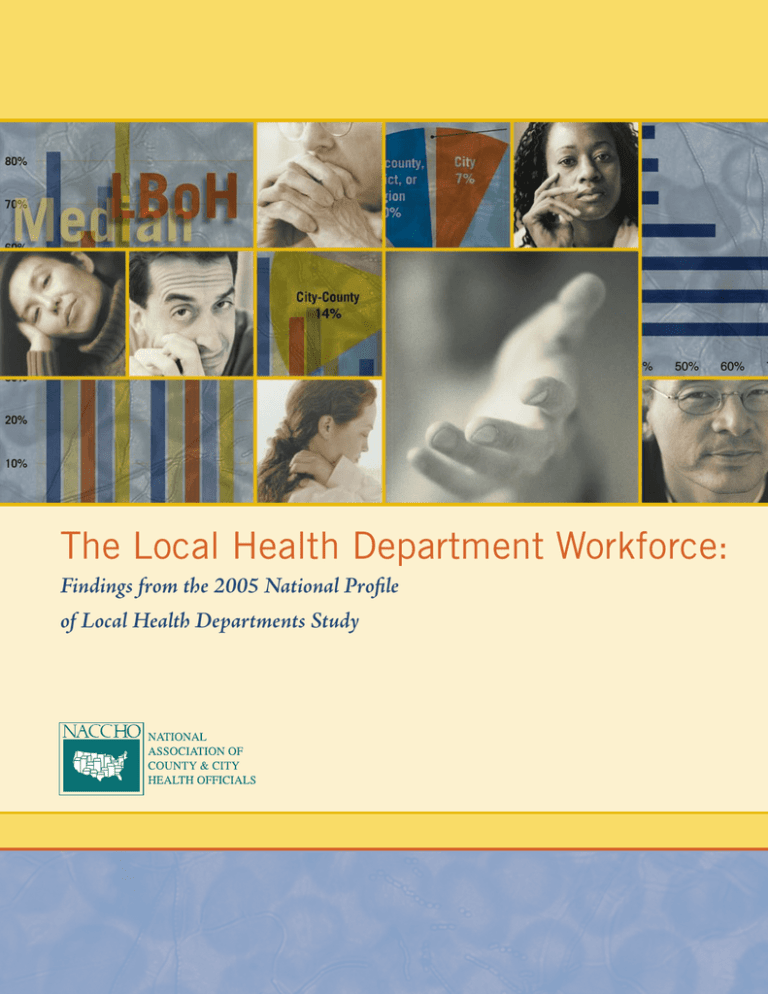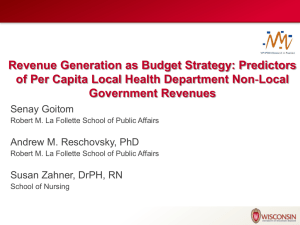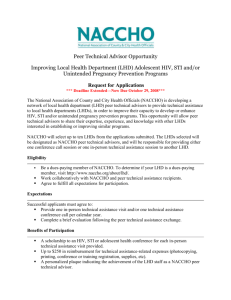The Local Health Department Workforce - NACCHO
advertisement

The Local Health Department Workforce: Findings from the 2005 National Profile of Local Health Departments Study Executive Summary The 2005 National Profile of Local Health Departments study (2005 Profile) demonstrates that nurses and environmental health professionals make up the largest percentages of the local health department (LHD) workforce (24% and 10%, respectively). Many LHDs are experiencing problems hiring these and other professional occupations, most frequently because of uncompetitive pay and benefits. LHDs anticipate shortages of staff in professional occupations to worsen over the next three years, due mainly to retirement and attrition for nurses and environmental health professionals and to new programs and program expansion for epidemiologists and health educators. LHDs are also experiencing challenges hiring diverse staffs that reflect the racial and ethnic composition of their jurisdictions. In approximately two-thirds of all LHD jurisdictions, the LHD staffs are less diverse than the population they serve. The changing practice of public health requires LHD staff members with skills in areas that were probably not part of their formal education, including informatics, communications, cultural competence, community engagement, and policy development. This makes on-the-job training critical for the LHD workforce. Most LHDs are familiar with Core Competencies for Public Health Workers (72%) and Emergency Preparedness Competencies for All Public Health Workers (65%), and many are using these competency sets to assess staff competencies and develop training plans. The state health agency and professional associations are the two external sources of training used by the largest number of LHDs. Forty-three percent of LHDs reported that their staffs had participated in training offered by a school of public health in the past year. LHD leaders expressed a strong preference for in-person and hands-on training methods rather than self-study methods. Developing effective training methods and courses and providing staff with time to participate in training are equally important in helping LHD staff members achieve and maintain the competencies needed for their jobs. NACCHO conducted the 2005 Profile study in cooperation with the Centers for Disease Control and Prevention. It was administered as a Web-based survey and included a core questionnaire (distributed to every LHD in the U.S., n=2,864) and three module questionnaires (each distributed to separate statistical samples of approximately 520 LHDs). The Local Health Department Workforce: Findings from the 2005 National Profile of Local Health Departments Study Introduction In its landmark 1988 report, The Future of Public Health, the Institute of Medicine characterized the nation’s public health system as “in disarray.”1 This prompted efforts over the following decades to systematically define public health,2 set goals for the public’s health,3 and identify performance standards for public health systems4 and local health departments.5 More recently, accreditation of state and local health departments has been proposed as a way to improve the performance and accountability of these governmental agencies.6 Events over the past several years have highlighted the vital role of local health departments (LHDs) in protecting the public’s health in instances of bioterrorism, emerging infectious diseases, and natural disasters. The results of the 2005 National Profile of Local Health Departments (2005 Profile) study suggest that the work of LHDs has changed significantly over the past decade. Many LHDs have reduced their focus on providing personal health services and certain environmental protection functions and have increased their focus on emergency preparedness, epidemiology and surveillance, and primary prevention.7 In addition, nearly all survey respondents reported an increase in collaboration with other agencies and community partners over the past few years.8 These changing and expanding LHD roles require new and different skills among members of the LHD workforce. In addition, the communities that LHDs serve are changing. U.S. Census Bureau estimates for 2005 show that 98 million people in the United States—about 33 percent of the total U.S. population of 296 million—are part of a racial or ethnic minority group. 9 In addition, 45 percent of children under age five are minorities. Finally, expectations of public health professionals are also changing. The Institute of Medicine recommended in 2003 that public health professional education include not only the long-recognized five core components of public health (i.e., epidemiology, biostatistics, environmental health, health services administration, and social and behavioral sciences), but that it also encompass eight new critical areas: informatics, genomics, communications, cultural competence, community-based participatory research, policy and law, global health, and ethics.10 This report summarizes information collected in the 2005 Profile study to examine several aspects of the LHD workforce: characteristics of workers, potential workforce shortages, and workforce training. Methods The 2005 Profile questionnaire was structured as a core questionnaire (sent to every LHD in the U.S., N=2,864) and three separate module questionnaires (sent to samples of approximately 520 LHDs each).11 The Profile study used stratified random sampling (by jurisdiction population size) to select LHDs to receive the Profile modules. The questionnaires were Web-based and were fielded from June through October 2005. Except for the data on numbers and occupations of LHD staff, all data presented in this report were collected in a Profile module. Extensive follow-up efforts resulted in an overall response rate of 80 percent for the core questionnaire, and 82 percent for the module that included workforce questions. Analysis of the module data included sample weighting to produce estimates for all LHDs and adjustments for non-response by population strata. Additional details about the methodology are available in the main study report.12 NACCHO The Local Health Department Workforce: Findings from the 2005 National Profile of Local Health Departments Study Results Characteristics of the LHD Workforce The total number of LHD workers (expressed in full time equivalents, or FTEs) in the U.S. estimated by the 2005 Profile study is 160,000.13 The number of individuals represented by this FTE calculation is unknown. Furthermore, it is important to remember that this number represents only a fraction of local governmental public Figure 1 | Occupations in the LHD Workforce health workers and an even smaller fraction of all public health Manager/director workers at the local level. The U.S. Census Bureau reports nearly 6% 250,000 FTE “health workers” employed by local government.14 This higher figure includes governmental public health workers from agencies other than LHDs, including those providing Not Nurse categorized emergency medical, mental health, substance abuse, animal 24% 23% control, and certain environmental health (EH) services. No reliable estimates are available for public health workers in nongovernmental organizations. These workers include employees of nonprofit organizations with a public health focus Clerical staff (e.g., American Cancer Society) and workers such as occupaEH specialist/ 27% tional health physicians, nurses, and industrial hygienists who scientist 10% provide public health functions for their private staffs. Public health nurses (24%) and EH specialists/scientists (10%) are the two professional categories that comprise the largest proportion of the LHD workforce (Figure 1). The 11 profesOther Profile categories 4% Nutritionist 3% sional categories included in the 2005 Profile questionnaire account for half of the LHD workforce. Clerical staff make up Figure 2 | L HD Staff by Race and Ethnicity 27 percent of the LHD workforce, and 23 percent of the workforce Race Ethnicity White Black Other races Hispanic was not placed into the selected occupations included in the 2005 All LHDs 74% 15% 10% 12% Profile questionnaire.15 16 Jurisdiction population Health educator 3% <50,000 50,000 - 499,999 500,000+ Census region Northeast Midwest South West 92% 6% 2% 3% 81% 12% 7% 11% The first national-level information about the race and ethnicity 55% 25% 20% 18% of LHD staff was collected in a 2005 Profile module (Figure 2). Approximately three quarters of 74% 15% 11% 12% LHD staff are White, 15 percent 82% 8% 10% 4% are Black, and 10 percent are other 68% 23% 8% 12% races. Approximately 12 percent 78% 5% 17% 23% of LHD staff are Hispanic. LHDs serving larger populations have higher percentages of staff that are races other than White and of Hispanic ethnicity than do those serving smaller populations. LHDs in the South (defined by Census region) have higher percentages of Black employees, and LHDs in the West have higher percentages of employees of other races and employees of Hispanic ethnicity, compared with other regions of the U.S.17 NACCHO The Local Health Department Workforce: Findings from the 2005 National Profile of Local Health Departments Study Racial communities other than White and many ethnic communities have been historically underrepresented in the public health workforce. The racial makeup of the staff of each LHD was compared to the racial makeup of the jurisdiction it serves. The results of this comparison are summarized in Figure 3. In approximately 68 percent of jurisdictions, the LHD staff is less diverse than the population it served (with a lower percentage of employees of races other than White, compared with the percentage of residents of races other than White within the jurisdiction). Figure 3 | D ifference in Diversity Between LHD Staff and Population Served Staff much less diverse (>10% difference) 26% Staff more diverse (>2% difference) 15% Staff and population served similar (difference within 2%) 16% Workforce Shortages A 2005 Profile module included a series of questions to assess current and anticipated problems in hiring five selected professional occupations: public health nurses; EH scientists/ specialists; health educators; epidemiologists; and information technology (IT) specialists. Staff less diverse (2 to 10% difference) 42% The results indicate that LHDs are currently most likely to have problems hiring public health nurses, with 46 percent of respondents who employ public health nurses citing problems hiring within this occupational category (Figure 4). Substantial percentages of respondents reported current problems hiring epidemiologists and EH scientists/ specialists (29% and 28% respectively of respondents who employ these occupations). Figure 4 | L HDs Reporting Current or Anticipated Problems in Hiring Selected Occupations 59% Public health nurses (n1=402, n2=402) 46% 38% Epidemiologists (n1=174, n2=188) 29% 39% EH scientists/specialists (n1=243, n2=249) 28% 20% 18% Health educators (n1=275, n2=294) n In 3 years n Currently 22% IT specialists (n1=200, n2=208) 15% 0% 10% 20% 30% 40% 50% Percentage of respondents Percentages reflect the percentage of LHDs that employ that occupation reporting hiring problems. n1=LHDs that currently employ each profession; n2=LHDs that anticipate employing each profession in three years NACCHO 60% 70% The Local Health Department Workforce: Findings from the 2005 National Profile of Local Health Departments Study Respondents gave a similar pattern of response when asked about anticipated future shortages of these occupations, though a higher percentage of respondents anticipate future shortages for each occupation compared with their current hiring situation. Fifty-nine percent of respondents whose LHDs employ public health nurses anticipate a shortage in three years. Thirty-nine percent of respondents whose LHDs employ EH scientists/specialists and 38 percent of respondents whose LHDs employ epidemiologists anticipate shortages of these occupations in three years. Less than 25 percent of respondents whose LHDs employ health educators and IT specialists are having problems currently hiring these occupations or anticipate shortages in the future. “Pay/benefits not competitive” was the most frequently selected reason for problems in hiring for every occupation (Figure 5). Overall, pay and benefits was selected nearly twice as often as the two next most cited problems: “Cannot hire due to budgetary restrictions” and “difficult to attract qualified candidates to this geographic area.” For all occupations, LHDs in rural areas cited difficulties attracting candidates to their geographic area more frequently than LHDs in urban areas. Figure 5 | R easons that LHDs are Currently Having Problems Hiring All Selected Occupations Reason Number of times cited across all occupations Percentage of all reasons cited Pay/benefits not competitive 364 29% Cannot hire due to budgetary restrictions 197 16% Difficult to attract qualified candidates to this geographic area 196 16% Candidates have insufficient experience 175 14% Candidates have insufficient education 121 10% LHD hiring process is cumbersome 102 8% Candidates have insufficient cultural and linguistic competency 40 3% Some other reason 42 3% Problems related to poor qualifications of candidates were selected less frequently than other problems in the hiring process. In general, insufficient experience was selected more frequently than insufficient education. Insufficient cultural and linguistic competency and a cumbersome LHD hiring process were rarely selected as reasons for difficulty in hiring among the selected occupations. Some differences in hiring problems are seen when the data for each occupation are examined separately (Figure 6). Uncompetitive pay and benefits are cited as problems more frequently for public health nurses and IT specialists than for the other occupations. Insufficient education and experience are cited less frequently as problems in hiring public health nurses than for the other occupations. The reasons that respondents anticipate shortages of workers vary by occupation (Figure 7). Staff attrition and retirement are the reasons cited most frequently for anticipated shortages among public health nurses and EH scientists/specialists. Program expansion was cited most frequently for epidemiologists and IT specialists, while new programs was cited most frequently for health educators. NACCHO The Local Health Department Workforce: Findings from the 2005 National Profile of Local Health Departments Study Figure 6 | R easons that LHDs are Currently Having Problems Hiring Selected Occupations Public health nurse EH scientist/ specialist Health educator Epidemiologist IT specialist Pay/benefits not competitive 91% 74% 64% 61% 82% Difficult to attract qualified candidates to this geographic area 45% 54% 40% 56% 29% Cannot hire due to budgetary restrictions 39% 46% 44% 52% 58% Candidates have insufficient experience 26% 44% 34% 46% 34% Candidates have insufficient education 15% 34% 31% 38% 25% Figure 7 | R easons that LHDs Anticipate a Shortage of Selected Occupations in Three Years 70% n Staff retirements n Staff attrition n Programs expansion n New programs n Some other reason Percentage of respondents 60% 50% 40% 30% 20% 10% 0% IT specialists Epidemiologists Health educators EH scientist/ specialists NACCHO Public health nurses The Local Health Department Workforce: Findings from the 2005 National Profile of Local Health Departments Study Workforce Training In response to concerns raised in The Future of Public Health, public health professionals in academia and practice began developing competencies to define the skills needed by the public health workforce. Core Competencies for Public Health Professionals was published in 2001.18 Subject-specific sets of competencies for public health workers in emergency preparedness19 and informatics20 were published shortly thereafter. Data collected in a 2005 Profile module indicate that many respondents are aware of some of these competencies, though fewer have begun to use them for workforce development (Figure 8). Seventytwo percent of respondents are aware of the Core Competencies for Public Health Workers, and 65 percent are aware of the Core Public Health Worker Competencies for Emergency Preparedness and Response, but fewer than half of all LHDs have used these competency sets in any way. A small percentage of LHDs (27%) are aware of the Public Health Informatics Competencies, but very few have used them. Of particular note is the very small percentage of LHDs that are using any of these competencies to develop job descriptions. Figure 8 | L HD Familiarity with and Use of Public Health Competencies Use of Competencies Core competencies for public health workers (Council on Linkages) Are familiar with Any reported Assess Develop Develop job use* competencies* training plans* descriptions* 72% 65% 47% 34% 27% Emergency preparedness competencies for all public health workers (Columbia University) 65% 70% 50% 50% 22% Public health informatics competencies (Northwest Center for Public Health Practice) 27% 26% 13% 11% 8% *Use percentages were calculated based on those respondents who indicated that they were familiar with the competency set. NACCHO The Local Health Department Workforce: Findings from the 2005 National Profile of Local Health Departments Study Many LHDs lack the basic workforce development infrastructure that is needed to ensure competent staff. Thirty-eight percent of all LHDs (and 43% of LHDs serving populations of less than 50,000) do not have a specific line item in their budgets for training of LHD staff. Fifty-seven percent of LHDs do not have a designated staff person responsible for coordinating training for LHD staff. Twenty-eight percent of LHDs have both a budget line item and a designated staff person for training. LHDs with a designated staff person responsible for coordinating staff training are more likely to have used the Core Competencies for Public Health Workers than LHDs without such a coordinator (59% versus 38%). The presence of a training coordinator does not appear to affect the use of the other two competency sets. LHDs that employ IT specialists are twice as likely to have used the Public Health Informatics Competencies than LHDs that do not (12% versus 6%). Data from the 2005 Profile module demonstrate that state agencies (particularly the state health agency) and professional associations are the major external sources from which LHD employees receive training (Figure 9). Eighty-five percent of LHDs conduct some of their own trainings for staff. Less than half of respondents reported that their staffs received training from a school of public health, college or university, or public health institute in the last year. Figure 9 | S ources of Training for LHD Staff Medical schools Other source Community colleges Public health institutes Colleges or universities Schools of public health Other state agency(ies) Professional associations or organizations LHD in-house training State health agency 0% 10% 20% 30% 40% 50% 60% 70% 80% Percentage of respondents NACCHO 90% 100% The Local Health Department Workforce: Findings from the 2005 National Profile of Local Health Departments Study The 2005 Profile module also collected data on the learning methods that LHD leaders would most support for their staffs (Figure 10). Respondents were asked to rank their top three choices from a list of learning methods. The learning method selected by far the most frequently was a classroom or workshop with a knowledgeable speaker (42% ranking first and 73% ranking in the top three). Other learning methods selected relatively frequently were distance learning courses and participation in real-time drills, exercises, or simulations. Few respondents gave independent study methods, such as CD-ROMs, videotapes, or printed materials, a high ranking. Figure 10 | L earning Methods that LHD Management Would Support for Staff Learning Method Percentage Percentage Ranking— Ranking— #1 Top 3 Classroom or workshop with knowledgeable speaker (e.g., lecture or large group presentation) 42% 73% Distance learning courses and programs (e.g., satellite downlinks, computer- and Internet-based courses/sessions) 19% 53% Learn one on one with an experienced professional in field/real-life situations (e.g., coaching, apprenticeships) 8% 30% Hybrid approach (combination of face-to-face classroom and distance-based platform) 8% 28% Participate in real-time exercises, drills, or simulations 7% 51% Teleconferencing 6% 30% Use of self-paced CD-ROM materials 4% 18% Use of audiotapes or videotapes 3% 13% Self-study using printed materials (e.g., manuals, books, articles) 3% 15% Number of Observations 315 321 Discussion Occupations of LHD Workers The finding that public health nurses and EH scientists/specialists comprise the majority of professional staff at LHDs is consistent with previous work.21 The typical staffing of the smallest LHDs includes these occupations along with a manager/director and clerical staff. Nutritionists, health educators, and emergency preparedness coordinators are common only in LHDs serving over 50,000 residents and the other professional categories are common only in LHDs serving over 100,000 residents.22 The categories included in the 2005 Profile study did not capture approximately 23 percent of the LHD workforce. A prior study of the Illinois workforce found that the state’s LHD workforce was evenly divided between professional and nonprofessional classifications.23 The only nonprofessional occupational category included in the 2005 Profile study was clerical staff (27% of workforce),24 suggesting that a large percentage of the uncategorized workers may be in nonprofessional categories (e.g., home health aides, inspectors, technicians, disease investigators). This hypothesis is consistent with anecdotal information from health officials that the majority of LHD staff in rural areas do not have bachelor’s degrees. Understanding the job duties and educational backgrounds of these LHD NACCHO The Local Health Department Workforce: Findings from the 2005 National Profile of Local Health Departments Study workers would help public health leaders to understand both how the U.S. educational system can better prepare future public health workers and how the skills of current public health workers can be strengthened. For example, community colleges can be effective venues for training public health workers for many paraprofessional positions. Workforce Recruitment and Retention NACCHO’s strategic plan includes an objective to “correct the under-representation of racial and ethnic communities in the public health workforce and leadership,” and NACCHO’s Board of Directors chose this objective as one of its six highest priorities for 2006. The 2005 Profile data confirm that this under-representation occurs in most LHD jurisdictions. In over two-thirds of LHD jurisdictions, the percentage of LHD staff who are people of color is lower than the percentage of people of color within the population of the jurisdiction served. LHD staff need to work with community partners, including at educational institutions and job training programs, to address this deficiency. The recruitment and retention practices of the LHDs that have successfully developed diverse staffs should be explored and shared with other LHDs. The 2005 Profile data on workforce shortages documents the challenges that LHDs face in recruiting and retaining professional staff. A key finding is that 46 percent of respondents reported problems in hiring public health nurses. Given that 95 percent of LHDs employ public health nurses and nurses comprise almost a quarter of the entire LHD workforce,25 this represents a very serious problem. LHDs need to work collaboratively with the education, business, and healthcare sectors in their communities to improve the supply of trained professionals. A large majority of respondents cited uncompetitive pay and benefits as a barrier to hiring for all of the professional occupations included in the questionnaire. In addition, geographic location is a recruitment barrier for many LHDs in rural areas. Given that geography is fixed and pay scales for public health workers are unlikely to change dramatically, LHD leaders need to understand what factors they can control to help attract and retain competent staff. As one health director said, LHD leaders should “make their LHD the employer of choice in the community.” A survey of the state and local public health workforce in Washington State found that 50 percent of these workers had been in the public health workforce for 10 years or more.26 Understanding what factors are most important in retaining workers will help LHD leaders to develop effective strategies for both staff recruitment and workforce development. The Council on Linkages Between Academia and Public Health Practice published a set of recommendations for improving the recruitment and retention of public health workers,27 many of which can be implemented by any LHD. These recommendations include: > Identifying and publicizing opportunities for people who begin at entry level to advance in LHDs. > Encouraging people with less training to enter public health professions and providing the training necessary to help them advance. > Alleviating stresses in the work environment (e.g., lack of administrative support, poor physical facilities, problems with “office politics”). > Improving personnel issues (e.g., streamlining the application process, better bonus and merit programs to reward good performance). > Evaluating and rewarding managers based on the effectiveness of their managerial practices. NACCHO 10 The Local Health Department Workforce: Findings from the 2005 National Profile of Local Health Departments Study Workforce Training Schools of public health receive funding through a number of federal programs that focus on training state and local public health workers (e.g., HRSA Public Health Training Centers, CDC Academic Centers for Public Health Preparedness). The 2005 Profile results suggest that the staffs of less than half of LHDs receive training from schools of public health. A decade ago, this might have been explained by the large number of LHDs that are not located in close proximity to a school of public health. The number of newly accredited programs in public health offering the MPH degree, and the increased focus by schools of public health on distance learning coupled with almost universal highspeed Internet access at LHDs, make this finding more puzzling in 2005. Though distance learning courses and programs were a distant second to traditional classroom-based training, a substantial number of respondents indicated support for them. Anecdotal evidence suggests that increasing demands on worker time and limited resources are barriers to undertaking training opportunities that are not required. In addition, there may be substantial limits on training opportunities that are out of state or external to their agencies, particularly for LHDs that are units of the state health agency. Schools of public health (and all providers of training for the public health workforce) should evaluate the marketing of their training opportunities intended for the LHD workforce to ensure that information about these opportunities is easily accessible to busy LHD employees. For example, if training resources developed at schools of public health are not included in the widely-used TRAIN learning management system,28 the number of LHD workers who are aware of the training opportunities offered by schools of public health will be reduced. Using multiple systems to identify and track training opportunities wastes scarce resources. This is particularly important for LHDs without a designated staff member responsible for coordinating staff training, which includes the majority of LHDs. In addition, providers of training programs should ensure that the trainings they offer meet the needs of the LHD workforce, in terms of both the preferred learning methods and the educational backgrounds of the learners. The 2005 Profile study indicates little enthusiasm for self-study methods (e.g., CD-ROM, videotapes, printed course materials) and other fairly passive learning methods such as teleconferences. This is consistent with studies that examined the training preferences of LHD workers in Ohio29 and Michigan.30 Organizations that develop training programs should consider how their trainings might be packaged in a way that could be adapted to a classroom setting in the contexts that most LHD employees actually receive training: in house, at the state health agency, or at a professional association. These organizations should also explore how to make the more cost-effective training methods (such as distance learning) more appealing to LHD staff. Developers and providers of training for LHD staff should also strive to include course offerings that are appropriate to the wide range of educational backgrounds of LHD staff. Courses intended for the graduate level are unlikely to be effective for the many LHD front-line staff who have not completed bachelor’s degrees. Community colleges might be useful partners in developing trainings for this segment of the LHD workforce. Other local governmental sectors with similar training needs (e.g., public safety) are also potential partners to LHDs in providing staff training. LHD leaders should also examine barriers to participation in staff training. A study of the preparedness training needs of Ohio LHD workers found that 56 percent cited the need to use vacation time to participate in training as a barrier to their participation.31 This problem could result from internal LHD policies, but also from restrictions in the activities of LHD employees whose salaries are paid through certain grant programs. In addition, certain grants restrict the employees who can be trained NACCHO The Local Health Department Workforce: Findings from the 2005 National Profile of Local Health Departments Study using grant funds to those specifically listed in the grant. More flexibility in the use of grant funds would remove some substantial barriers to staff training. LHD leaders also must consider what they can do to strengthen their staffs by cultivating learning organizations and cultures of continuous education. Conducting competency-based assessments and offering training allows workers to strengthen existing skills, learn new skills, and adapt to changing environments. LHD leaders need to work with elected officials to assure funding for training, addressing issues of both time and money. LHD leaders should provide incentives to promote staff training both to managers (e.g., making workforce development an important aspect of their evaluation) and to other staff (e.g., giving them time on the job to learn or offering salary incentives for participation in continuing education programs). Conclusions Over half of the LHD workforce comprises public health nurses, EH scientists/specialists, and clerical staff. Though information on the educational attainment of LHD workers is not available, data on occupations suggest that the percentage of LHD workers who received public health training in their formal educations is relatively low. Furthermore, the knowledge needed for effective public health practice is constantly increasing. A strong on-the-job training program is needed to ensure that LHD workers achieve and maintain the public health competencies required to do their jobs effectively. LHD staff prefer in-person and hands-on training to distance-learning or self-study methods, but these methods are often expensive and LHD funds for training are limited. Increasing flexibility in the use of various LHD funding streams would increase the funds available to support staff training. Tailoring training courses to be appropriate to the range of educational backgrounds of LHD staff will make them both more effective for and attractive to workers. LHD staff need well-organized information about training opportunities in a single location. Many LHDs are experiencing problems hiring staff in several professions (most frequently public health nurses), and more anticipate shortages in the future. In addition, the diversity of the staffs of most LHDs does not reflect the diversity of the communities they serve. Research is needed to identify successful strategies for recruiting and retaining LHD workers, especially people of color. The LHD workforce needs to be competent and diverse in order to achieve public health goals. (Endnotes) 1 Institute of Medicine. (1988). The Future of Public Health. Washington, DC: National Academy Press. 2 U.S. Public Health Service, Public Health Functions Steering Committee. (1994). Public Health in America. Washington, DC. 3 U.S. Department of Health and Human Services. (2000). Healthy People 2010: Understanding and Improving Health (2nd ed.). Washington, DC: U.S. Government Printing Office. 4 U.S. Department of Health and Human Services. (2006). National Public Health Performance Standards Program User Guide. Available from http://www.cdc.gov/od/ocphp/nphpsp/ Documents/NPHPSPuserguide.pdf 5 National Association of County and City Health Officials. (2005). Operational Definition of a Functional Local Health Department. Washington, DC: NACCHO. Available from http://www.naccho.org/topics/infrastructure/ operationaldefinition.cfm NACCHO 11 The Local Health Department Workforce: Findings from the 2005 National Profile of Local Health Departments Study 12 6 Association of State and Territorial Health Officials and National Association of County and City Health Officials. (2006). Exploring Accreditation: Final Recommendations for a Voluntary National Accreditation Program for State and Local Health Departments. Available from http:// www.exploringaccreditation.com/ 7 National Association of County and City Health Officials. (2006). 2005 National Profile of Local Health Departments (page 58). Washington, DC: NACCHO. 8 National Association of County and City Health Officials. (2006). 2005 National Profile of Local Health Departments (page 68). Washington, DC: NACCHO. 9 U.S. Census Bureau. (2005). Annual Estimates of the Population by Sex, Race and Hispanic or Latino Origin for the United States: April 1, 2000 to July 1, 2005 . Available from http://www. census.gov/popest/national/asrh/NC-EST2005-srh.html 10 Institute of Medicine. (2003). Who Will Keep the Public Healthy: Educating Public Health Professionals for the 21st Century. Washington, DC: National Academy Press. 11 The 2005 Profile core and module instruments are available at http://www.naccho.org/topics/infrastructure/2005Profile.cfm. 12 National Association of County and City Health Officials. 17 U.S. Census Bureau. Census Regions and Divisions of the United States. Available from http://www.census.gov/geo/www/us_ regdiv.pdf 18 Council on Linkages Between Academia and Public Health Practice. (2001). Core Competencies for Public Health Professionals. Available from http://www.phf.org/competencies.htm 19 Columbia University School of Nursing, Center for Health Policy. (2001). Core Public Health Worker Competencies for Emergency Preparedness and Response. Available from http://www.mailman.hs.columbia.edu/CPHP/cdc/ COMPETENCIES.pdf 20 Northwest Center for Public Health Practice. (2002). Public Health Informatics Competencies. Available from http:// nwcphp.org/resources/phicomps.v1 21 Health Resources and Services Administration. (2000). The Public Health Work Force: Enumeration 2000. Rockville, MD: U.S. Department of Health and Human Services. 22 National Association of County and City Health Officials. (2006). 2005 National Profile of Local Health Departments (page 32). Washington, DC: NACCHO. 23 Turnock, BJ, Hutchinson, KD. (2000). The Local Public Health (2006). 2005 National Profile of Local Health Departments (page 2). Washington, DC: NACCHO. Workforce: Size, Distribution, Composition, and Influence on Core Function Performance, Illinois 1998-1999. Chicago: Illinois Center for Health Workforce Studies. 13 National Association of County and City Health Officials. 24 The category “environmental health specialist” may include (2006). 2005 National Profile of Local Health Departments (page 34). Washington, DC: NACCHO. 14 U.S. Census Bureau. (2005). Federal, State, and Local Governments Public Employment and Payroll Data (local government data, 2005). Available from http:// www.census.gov/govs/www/apes.html 15 See note 13. 16 Occupations included in the 2005 Profile questionnaire were health services manager/administrator/health director, nurse, physician, environmental health specialist, other environmental scientist or technician, epidemiologist, health educator, nutritionist, information systems specialist, public information specialist, emergency preparedness coordinator, and administrative or clerical personnel. Note that the category “health services manager/administrator/health director” includes individuals with varied educational backgrounds (e.g., administrators, nurses, physicians, environmental health professionals, etc.) serving in managerial positions. both professional and non-professional staff. 25 National Association of County and City Health Officials. (2006). 2005 National Profile of Local Health Departments (pages 31, 34). Washington, DC: NACCHO. 26 Washington State Department of Health. (2004). Everybody Counts: The Public Health Workforce in Washington State. Olympia, WA: Washington State Department of Health. 27 Council on Linkages Between Academia and Public Health Practice. (2006). Strategies to Address Public Health Worker Shortages. Available from http://www.phf.org/Link/ RR-Strategies.htm 28 Public Health Foundation. (2006). TRAIN. Available from https://www.train.org/DesktopShell.aspx 29 Ohio State University School of Public Health. (2004). Public Health Workforce Training Needs Survey. 30 Michigan Public Health Training Center. (2001). Training Needs Survey. 31 See note 29. NACCHO Acknowledgments This report was authored by Carolyn J. Leep, who also served as study director for the 2005 National Profile of Local Health Departments study. The following people provided guidance on direction of this report and comments on draft versions: Carol Brown, NACCHO; Mary Kay Burns, DeSoto County (FL) Health Department; Joan Cioffi, Centers for Disease Control and Prevention; Theresa Daub, Centers for Disease Control and Prevention; John Dreyzehner, Cumberland Plateau Health District (VA); Kristine Gebbie, Columbia University; Elizabeth Ransopher, Columbus (OH) Public Health; Christine Rosheim, Centers for Disease Control and Prevention; Bernard Turnock, University of Illinois at Chicago. NACCHO gratefully acknowledges the financial support of the Centers for Disease Control and Prevention, which made the 2005 National Profile of Local Health Departments study possible. NACCHO is the national organization representing local public health departments. NACCHO works to support efforts that protect and improve the health of all people and all communities by promoting national policy, developing resources and programs, seeking health equity and supporting effective local public health practice and systems. Funding for this project was provided by the Centers for Disease Control and Prevention (under cooperative agreement U50/CCU302718). The contents of this document are solely the responsibility of the authors and do not necessarily represent the official views of the sponsor. January 2007 1 1 0 0 1 7 th S treet, NW 2nd Fl o o r Wa sh in g t on , DC 20036 ( 2 0 2 ) 7 8 3 - 5 550 ( 2 0 2 ) 7 8 3 - 1 583 Fax www. n a ccho.org






